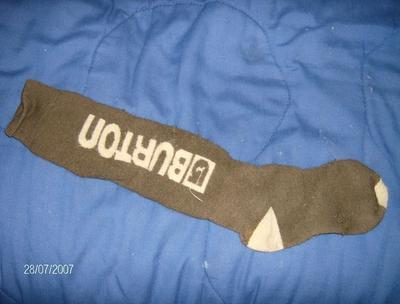Over the past few weeks or so, I have noticed many threads on boots. "Which boots should I get?", "ZOMGZZZ new SPK's?", How do the Lange FR 120's feel?" and so forth.
I don’t really know how to say this, but we cant possibly recommend you a boot on the internet- however, you can assess and recommend your own boot. This may be a lot of writing, but, hopefully I cover everything. If anyone else has anything to add, please do so.
For a proper fit, you have to try on many different models and styles of boots. The SPK has a completely different fit than a Lange FR 120, as does a Krypton and a Scratch. You must try boots on to see what fits the shape of your foot. Your foot has many dimensions that have to be taken into account when trying them on, including length, width, height, and overall shape.
Keep in mind, if you’re a park skier, you may want to look into more park specific boots. Yet, you don’t NEED a park boot for park. Simon Dumont was riding some rec. boots for quite some time. THE FIT, FLEX, AND CLOSEUR SYSTEM ARE MORE IMPORTANT THAN WHAT THE BOOT IS DESCRIBED TO DO
When getting a boot fit, try to shop when there is no one else around. That will ensure the fitter's undivided attention is focused on you. Hey, even boot fitters get distracted sometimes too!
Some things to watch out for at a boot fitter are variant. If the fitter asks your shoe, you may want to leave. Your shoe size has nothing to do with boots.
If the fitter isn’t asking you about your skiing, you may want to leave. He/she needs to know what type of skiing you will be doing to effectively recommend a boot.
If you, for ANY reason feel that the fitter isn’t doing their job the best they can, don’t hesitate to leave. Your not being rude, your just looking for the best boot possible.
However, some people don’t have access to a boot fitter. If you CAN'T, here are some things to try.
Getting Started
1. Look at your foot, and get an idea of the shape.
For example, here is my foot. I have a moderately wide middle, narrow heel, and moderately wide toe area. So, I need a moderately wide boot.

People with wider feet may have better luck with brands such as, but not limited to: Salomon, Rossignol, and Nordica.
People with narrower feet may have better luck with brands such as, but not limited to: Dalbello, Lange, and Atomic.
(note: different models have different fits. This is just a VERY general guideline.)
2. Fit
Socks
When trying on the boots at the shop, be sure to wear ski socks. Athletic sock, ankle socks, and dress socks are very different. If you don’t have a pair of ski socks, you should really consider in investing in a pair. I use BURTON snowboard socks, just so you know.
[img]http://img260.imageshack.us/img260/1637/picture009jr4.jpg /img]
Do your own Shell Fit. Remove the liner from the boot, and put your foot into the empty shell. Push your foot forward until your toes hit the end on the toe box. You should have about 1", to 1 1/2" between the back of your heel and the shell. If this is the case, the shell is generally the right size for you.
The boot should feel snug. Remember, that all boots will pack out, sometimes after a few runs. You can gain up to 1 cm or so in room after this occurs.
Remove the liner carefully. You can rip them if there is sharp plastic, or something of the sort in the boot.

Here is my shell fit. I have exactly 1 inch.

Never go by the manufactures sizing, or your shoe size. Simply use these as guidelines. A 27.5 Salomon Foil and a 27.5 Salomon SPK are different sizes. If I know you’re a size 9.5, I’m going to try on the 27.5, bust to see. Its not like, “There’s a 27.5, I’m buying it!”

DON’T BUY YOUR BOOTS TOO BIG. THIS CAN CAUSE INJURY, AND RUIN YOUR FUN ON THE SLOPES!!
3. Put the boot on, with the liner in, and buckle it up. Get a feel for it by flexing it forward. Keep in mind the boot is going to feel substantially stiffere when your out riding in the cold. If you feel pressure points, you probably don’t want that specific boot.

Some boots have a lot of adjustability. I’ve moved the instep buckle of my foils to the back position. This helps to keep my narrow heel locked into the heel cup, but pulling it downwards and back, much like a snowboard binding, or a Dalbello Krypton boot.

4. Take your time!
Take your time! Take your time! Take your time! I can’t stress this enough! Patience is crucial in buying good fitting boots.
Buying boots isn’t an impulse purchase like a cute handbag or a trashy mini-skirt! A good analogy is dating. Your almost never marry your first girlfriend, and the same with boots. You need to go out with as many girls(boots) as you can, and then marry(purchase) the one that you love(fits) you best. There are plenty of great boots out there, so try on many, and you will find the perfect one!
Another way to improve your experience is to go shopping for boots alone. If your going with a friend/parent, your opinions can actually be swayed by their own. Also, try to leave the look of the boot out of your final decision. Its great to have a good looking boot, but if you are buying more for the looks, you will sacrifice comfort and performance.
Look for boots over the summer. This way, you wont feel any rush to buy them, and, in doing so, may come across another boot, or a better deal later on.
5. Price
Don't let the price of the boot intimidate you. Often, the more you spend, the better quality you are getting. Think of boots as an investment in your skiing, and your comfort on the hill. If you see boots that aren’t in your budget, try to get a deal on them, or buy the boots first, and buy your skis/bindings later. Your cant put a price on comfort! I paid 400$ for my Foils after the final fitting, and I couldn’t be happier with my purchase. I was only planning on spending 200$, but, I’m very glad I spent the extra money.
6. Comfort?
Too comfortable can be a problem. Too many folks look for boots that feel cozy, like a well-worn pair of bedroom slippers. The biggest mistake you can make is buying too big. Boots should fit snugly—like a firm handshake. But, when you ski as little as three runs, the boot will pack out. And, remember, you’re dealing with new, stiff pieces of foam, plastic and leather. It takes a while to break those materials in. If they feel a bit tight in the shop, keep them on for fifteen minutes and let them set into your foot.
7. Cuff
Never buy a boot without cuff adjustment. Practically every boot nowadays does, but just keep that in mind. Macro-Adjust buckles, power-straps, canting, and other cuff and tongue adjustability is great, but not something to be played around with, especially canting.

8. Type of skier?
Think about what kind of skiing you plan to do. Typically, a park skier will want a boot more flexy and forgiving. Someone charging in the backcountry will want a stiffer, more responsive boot.
Flex Guide
These are only a guideline, remember, its all personal preference.
All companies flex indexes are different, and your personal preference varies, but here it goes.
Park- 70-85
All Mtn.- 80-95
BC- 90-110
Charging- 105-120
9. Shape of the boot.
When looking at boots, look for one that traces the same shape as you calf. People with a smaller calf will need a different shape than people with a wider calf. Some boots have adjustments that can be made to increase and decrease volume in this area. It is important that this is not too tight-you may loose circulation and have cold feet, yet it is important it is not too loose- the dreaded shin bang!
10. Final "Steps"
Be sure to try on BOTH boots. Your left foot may be different from your right foot, so be sure to try on both. I cant stress enough to TAKE YOUR TIME. Sit in the shop for 45 minutes with the boots on. I’m sure they wont care, unless the owner secretly hates you.
Liner
Be sure to wear your new boots around after you buy them to break them in. Some models have a heat-moldable liner. This allows for a more custom fit. A heat mold can be done at your shop. They heat the liner, then you put your boot on, buckle it tight, and just sit, and walk around for about 45 minutes.
For some boots that are higher quality, you can swap out various liners. I know you can do this with some Dalbello boots, switching out the stock liner for an ID liner. I can always get another Salomon liner from a boot using the same mold, but I’m content with mine.

You can also invest in custom footbeds and orthotics. These are all fine tweaks you can do to improve the fit of your boots.
If you have any other questions, feel free to PM me and I'll try to help out as much as I can!





























